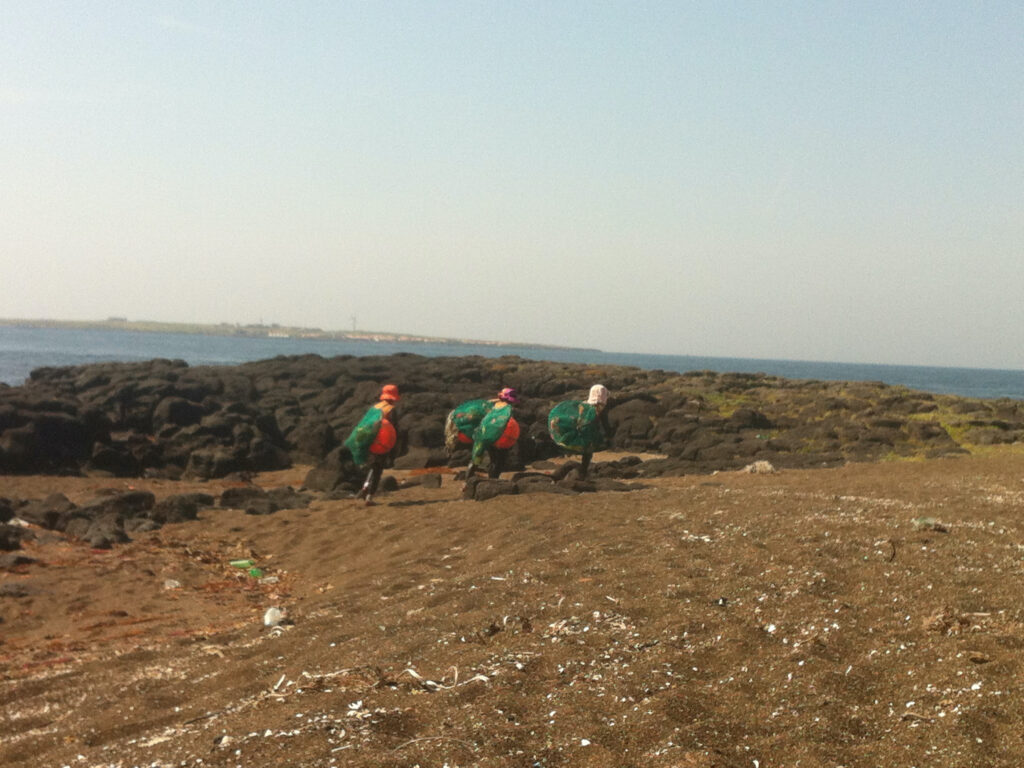Jeju has long been known for having three things in abundance, called the samda.
These Three Abundances of Jeju Island are wind, women and stone.
Wind

Given its location in the sea, Jeju experiences strong winds throughout the year. There are occasional typhoons in summer and fall. The wind played an important role in the well-being of the people of Jeju, for successful fishing and maritime trade and travel depended on favorable conditions. Heavy rains and rough waves often made diving and fishing difficult, dangerous or impossible. Fishermen, farmers and the diving women of Jeju known as haenyeo perform a ritual on the first of every February to welcome Grandmother Yeongdeung, the goddess of wind. She brings with her seeds for the coming spring, renewing the growth of seaweed, barley, fish and other crops that the islanders depend on. After traversing the island from her entry point in Gwideok Village, she passes through Udo, the easternmost islet of Jeju, two weeks later on her way home. At this time another ceremony is held to wish the goddess farewell.
Women

The giant goddess Grandmother Seolmundae is said to have created Jeju’s landscape, and many other goddesses are honored on the island. Until recently, women outnumbered men on Jeju; men often perished at sea during fishing and trading expeditions. The women of Jeju worked the fields and dove for seafood in addition to raising children and taking care of the housework. Life was not always easy, but Jeju’s women are renowned for their strength, resilience and strong spirit. They still help plant and harvest crops, and in the past they had to carry heavy loads of water in ceramic jars called heobeok, often having to cover long distances to get it.
Haenyeo, the diving women of Jeju, have a very challenging and often dangerous occupation, diving throughout the year, even in frigid winter temperatures. They hold their breath for astonishingly long periods of time as they work far beneath the waves harvesting the nutritious and commercially viable bounty of the sea, such as seaweed, octopus, abalone and other shellfish. When they surface, they exhale by making a special whistle which helps expel nitrogen from their blood. This is called sumbi sori. They form close-knit, informal communities who honor hard work, bravery and generosity, and formal organizations that prevent over-fishing and otherwise regulate their industry. It is not uncommon for haenyeo to dive well into their 70s and 80s, and sell the products they have harvested at local markets.
Stone

The volcanic rock from which Jeju was primarily formed, called basalt, is present virtually everywhere on the island. Much of it eventually split into piles and fields of rocks and boulders. Unique forests known as gotjawal grow in humid areas where many boulders are clustered together. With thin soil and many dry riverbeds, along with Jeju’s many striking natural rock formations, from hexagonal rock pillars to soaring cliffs and miles of lava tubes, stone is an ever-present feature of the landscape. The ubiquitous stone walls surrounding Jeju’s orchards, fields and houses, called batdam, were built with gaps between the rocks to allow the wind to pass through. This prevented them from falling over during typhoons. Graves also have stone walls called sandam to prevent the intrusion of animals.
From the earliest times, islanders’ lives were intimately connected to the use of stone, which was fashioned into a great variety of tools and implements for use in daily and spiritual life. Mortars, pestles, grinding stones and hollowed-out stone braziers were used for processing food and cooking, while basalt was used to construct the incense burners used during ancestor memorial rites. The early founders of the ancient state of Tamna are thought to have constructed the island’s many dolmen, called goindol or jiseokmyo, some of which have capstones that weigh many tons. Stone daggers have been found near the dolmen and in burial sites below them. At the entrance to villages stood dolhareubang (stone grandfathers), pairs of statues facing each other and serving as village guardians. Smaller statues known as dongjaseok (stone boys) watch over gravesites. Tosinham were miniature stone houses built as sacred enclosures for the god Chilseongsin.
Sammu

Along with the samda, Jeju Island is also renowned for its fortunate absence of three things – beggars, gates and thieves. These are collectively called the sammu.
